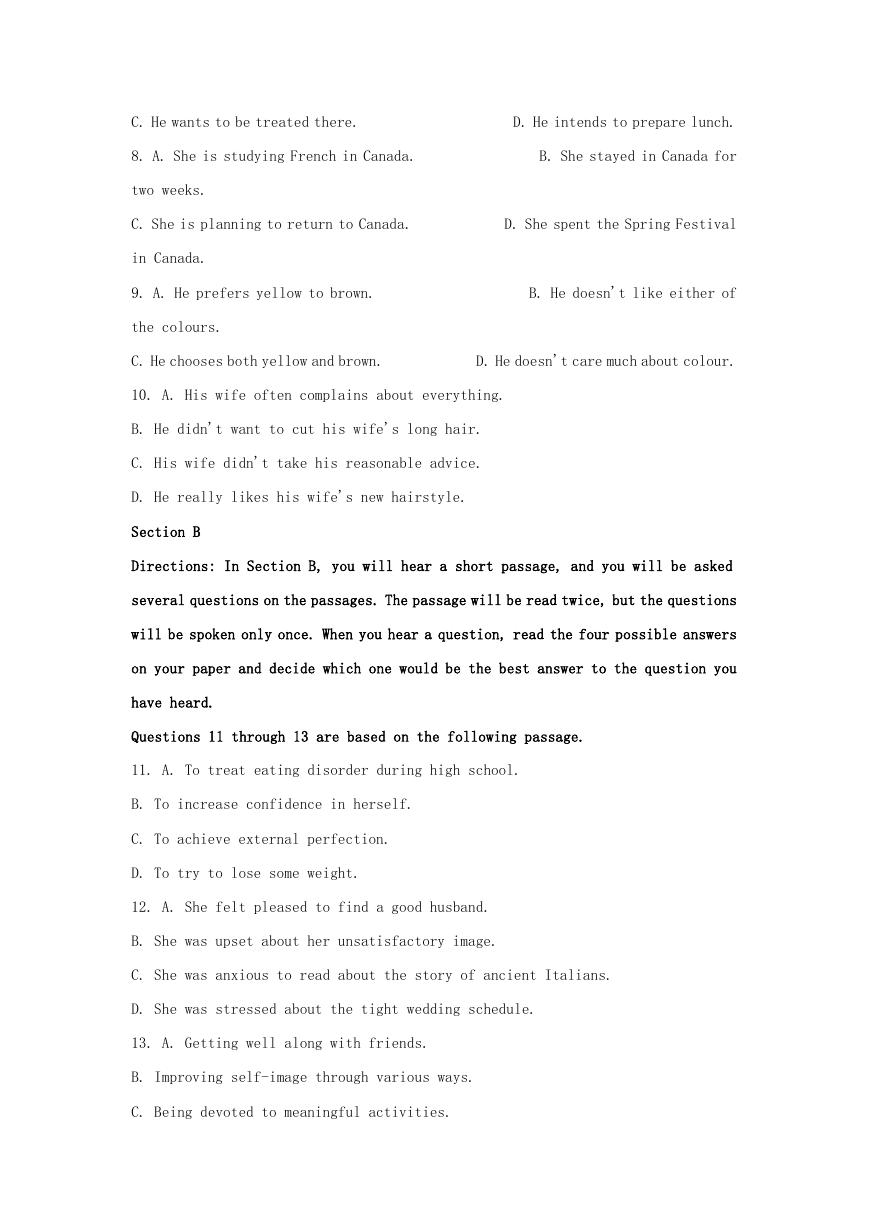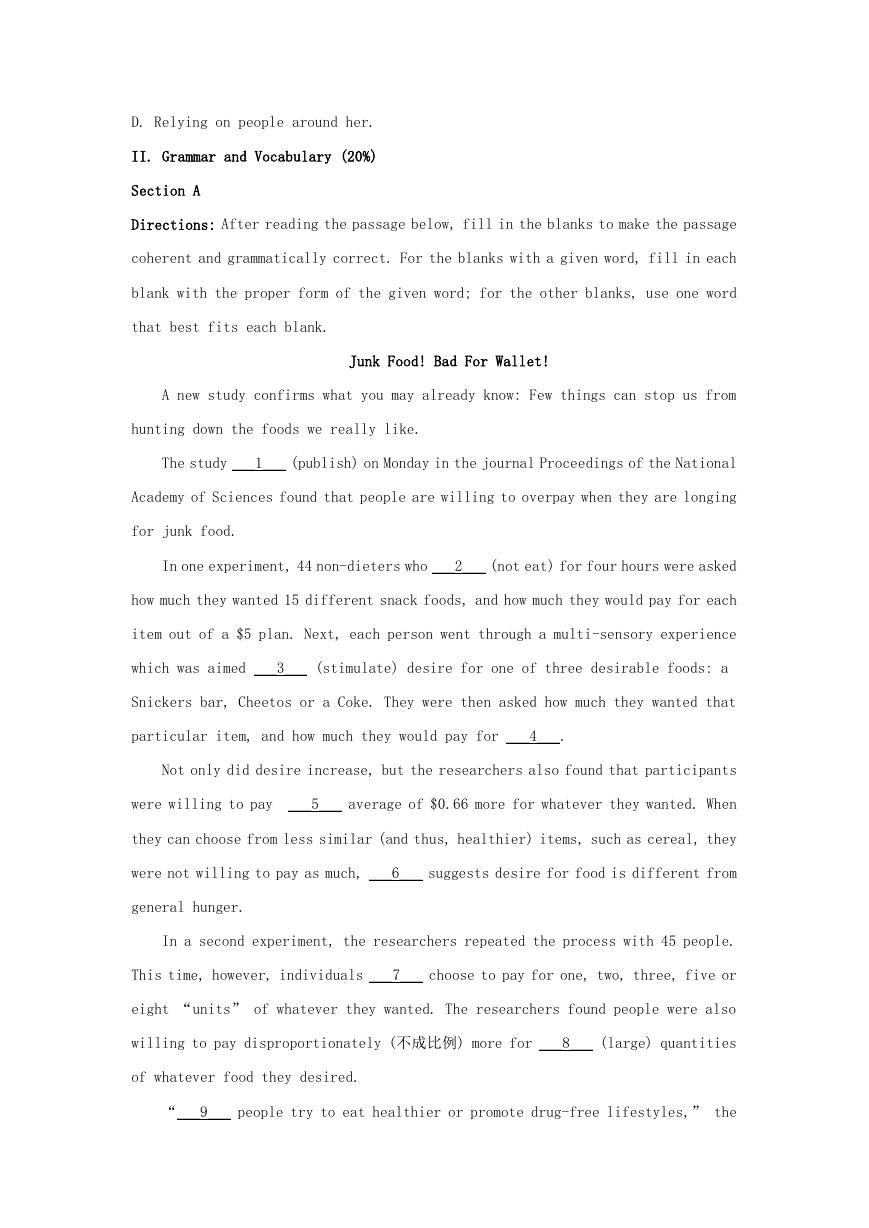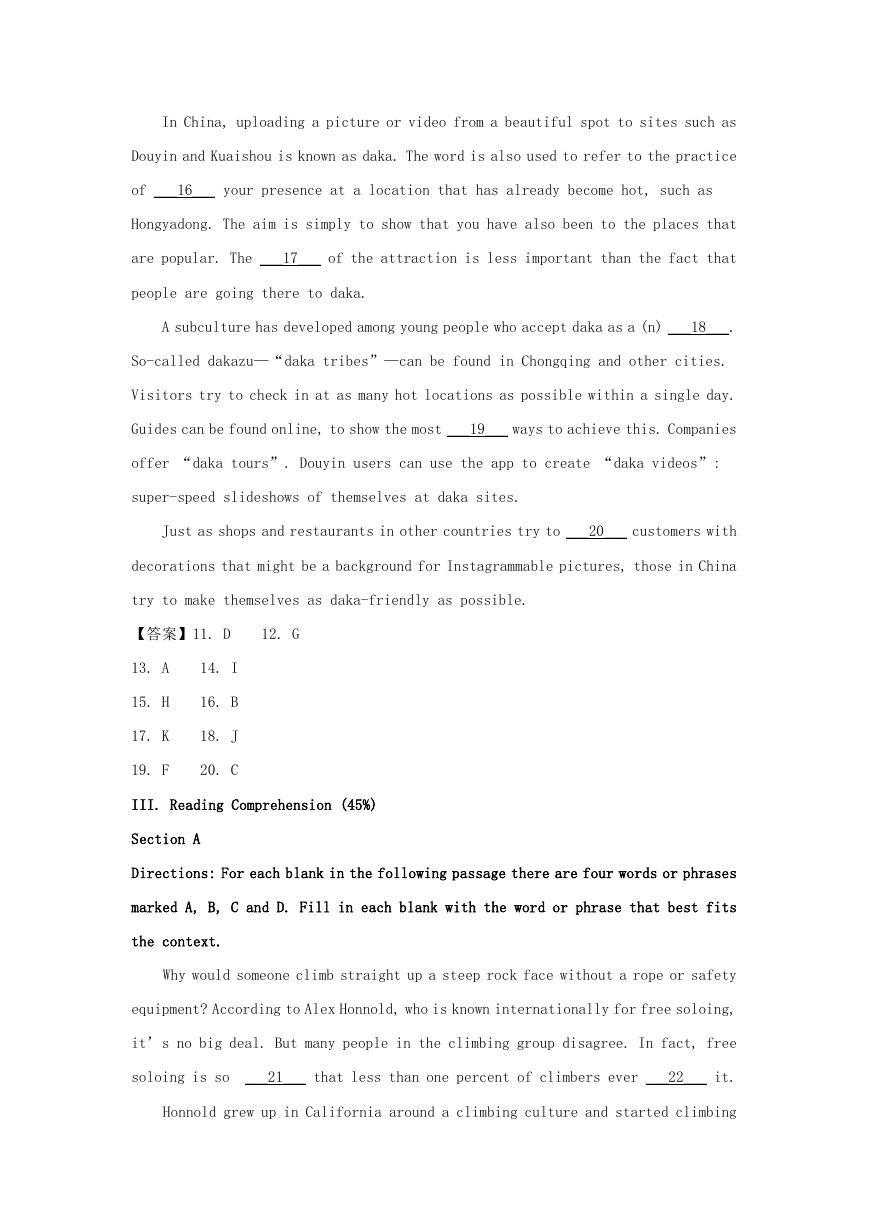2021-2022 年上海市徐汇区高一英语上学期期末试卷及答案
I. Listening Comprehension (16%)
Section A
Directions: In Section A, you will hear ten short conversations between two speakers.
At the end of each conversation, a question will be asked about what was said. The
conversations and the questions will be spoken only once. After you hear a
conversation and the question about it, read the four possible answers on your paper,
and decide which one is the best answer to the question you have heard.
1. A. At home.
C. At school.
B. In his office.
D. In the meeting room.
2. A. Boss and secretary.
B. Brother and sister.
C. Teacher and student.
D. Customer and shop assistant.
3. A. The man needs to be up all night.
B. It’s wise of the man to
study English.
C. The man should get some sleep.
D. It’s easy for the man to stay
up late.
4. A. Two.
Six.
B. Three.
C. Four.
D.
5. A. She used to be healthier.
B. Jogging does do good to
her.
C. She didn't like exercise before.
D. Jogging is never part of her
life.
6. A. The woman is willing to teach the man to use the machine.
B. The man doesn't want to be bothered by the woman.
C. The clerk should have made more copies.
D. The clerk won't come back to make any copies.
7. A. He likes to eat Italian food.
B. He wishes to pay the bill.
�
C. He wants to be treated there.
D. He intends to prepare lunch.
8. A. She is studying French in Canada.
B. She stayed in Canada for
two weeks.
C. She is planning to return to Canada.
D. She spent the Spring Festival
in Canada.
9. A. He prefers yellow to brown.
B. He doesn't like either of
the colours.
C. He chooses both yellow and brown.
D. He doesn't care much about colour.
10. A. His wife often complains about everything.
B. He didn't want to cut his wife's long hair.
C. His wife didn't take his reasonable advice.
D. He really likes his wife's new hairstyle.
Section B
Directions: In Section B, you will hear a short passage, and you will be asked
several questions on the passages. The passage will be read twice, but the questions
will be spoken only once. When you hear a question, read the four possible answers
on your paper and decide which one would be the best answer to the question you
have heard.
Questions 11 through 13 are based on the following passage.
11. A. To treat eating disorder during high school.
B. To increase confidence in herself.
C. To achieve external perfection.
D. To try to lose some weight.
12. A. She felt pleased to find a good husband.
B. She was upset about her unsatisfactory image.
C. She was anxious to read about the story of ancient Italians.
D. She was stressed about the tight wedding schedule.
13. A. Getting well along with friends.
B. Improving self-image through various ways.
C. Being devoted to meaningful activities.
�
D. Relying on people around her.
II. Grammar and Vocabulary (20%)
Section A
Directions: After reading the passage below, fill in the blanks to make the passage
coherent and grammatically correct. For the blanks with a given word, fill in each
blank with the proper form of the given word; for the other blanks, use one word
that best fits each blank.
Junk Food! Bad For Wallet!
A new study confirms what you may already know: Few things can stop us from
hunting down the foods we really like.
The study ___1___ (publish) on Monday in the journal Proceedings of the National
Academy of Sciences found that people are willing to overpay when they are longing
for junk food.
In one experiment, 44 non-dieters who ___2___ (not eat) for four hours were asked
how much they wanted 15 different snack foods, and how much they would pay for each
item out of a $5 plan. Next, each person went through a multi-sensory experience
which was aimed ___3___ (stimulate) desire for one of three desirable foods: a
Snickers bar, Cheetos or a Coke. They were then asked how much they wanted that
particular item, and how much they would pay for ___4___.
Not only did desire increase, but the researchers also found that participants
were willing to pay
___5___ average of $0.66 more for whatever they wanted. When
they can choose from less similar (and thus, healthier) items, such as cereal, they
were not willing to pay as much, ___6___ suggests desire for food is different from
general hunger.
In a second experiment, the researchers repeated the process with 45 people.
This time, however, individuals ___7___ choose to pay for one, two, three, five or
eight “units” of whatever they wanted. The researchers found people were also
willing to pay disproportionately (不成比例) more for ___8___ (large) quantities
of whatever food they desired.
“___9___ people try to eat healthier or promote drug-free lifestyles,” the
�
researchers write in the paper, “desire could overshadow (使逊色) the value of
health by boosting the values of unhealthy foods and drugs.”
On the bright side, however, the researchers estimated the effects _____10_____
subjects’ desire would disappear within two hours, and probably less time if this
good is not available, or when a person is self-regulated.
【答案】1. published
2. hadn’t eaten
3. to stimulate
4. it
5. an
6. which
7. could
8. larger
9. Although##Though##While
10. of
Section B
Directions: Complete the following passage by using the words in the box. Each word
can only be used once. Note that there is one word more than you need.
A. popularity
B. recording
C. draw
D. attraction
E. risking
F.
efficient
G. increase
H. impress
I. transformed
J. lifestyle
K. beauty
Located on cliffs above a river, Hongyadong is a stilt-house complex (高脚屋
建筑群) in traditional style in Chongqing. Its bars, restaurants and golden neon
lights have been a popular ___11___ since it was built in 2006. The past few years
have seen an explosive ___12___ in the number of visitors.
The main reason, it seems, has been Hongyadong’s sudden___13___ on Douyin. For
a while, it became the biggest attraction in China after only the Forbidden City,
according to travel website Mafengwo.
Social media has ___14___ tourism worldwide. Instead of having fun, some people
now went to remote strawberry farms to take photos to ___15___ their friends on
Instagram. But unlike Instagram users, Douyin’s fans commonly use the app to watch
popular videos posted by strangers.
�
In China, uploading a picture or video from a beautiful spot to sites such as
Douyin and Kuaishou is known as daka. The word is also used to refer to the practice
of ___16___ your presence at a location that has already become hot, such as
Hongyadong. The aim is simply to show that you have also been to the places that
are popular. The ___17___ of the attraction is less important than the fact that
people are going there to daka.
A subculture has developed among young people who accept daka as a (n) ___18___.
So-called dakazu—“daka tribes”—can be found in Chongqing and other cities.
Visitors try to check in at as many hot locations as possible within a single day.
Guides can be found online, to show the most ___19___ ways to achieve this. Companies
offer “daka tours”. Douyin users can use the app to create “daka videos”:
super-speed slideshows of themselves at daka sites.
Just as shops and restaurants in other countries try to ___20___ customers with
decorations that might be a background for Instagrammable pictures, those in China
try to make themselves as daka-friendly as possible.
【答案】11. D
12. G
13. A
14. I
15. H
16. B
17. K
18. J
19. F
20. C
III. Reading Comprehension (45%)
Section A
Directions: For each blank in the following passage there are four words or phrases
marked A, B, C and D. Fill in each blank with the word or phrase that best fits
the context.
Why would someone climb straight up a steep rock face without a rope or safety
equipment? According to Alex Honnold, who is known internationally for free soloing,
it’s no big deal. But many people in the climbing group disagree. In fact, free
soloing is so
___21___ that less than one percent of climbers ever ___22___ it.
Honnold grew up in California around a climbing culture and started climbing
�
at 10. He ___23___ going to a climbing gym six days a week for three hours a day.
Honnold was a straight-A student in school. But climbing was his main ___24___, and
free soloing quickly became his favorite style. ___25___ he began climbing, he has
made over a thousand climbs. He is ___26___ by many to be the best climber in the
world. Experienced climber John Long says over half of the famous free solo climbers
are dead. According to him, Honnold's greatest achievement is that he's still
___27___.
Honnold climbs by fitting his fingers into the cracks of the rock face. With
most of his ___28___ supported by his fingers alone, he pulls himself up. What's
more, his ability to stay focused is as ___29___ as his strength.
Other climbers agree that the fear of climbing without a(n) ___30___ is a huge
challenge to overcome. Everyone knows that a single ___31___ would probably be a
deadly one.
One of his greatest achievements ___32___ in California’s Yosemite National
Park. He became the first free solo climber to ___33___ the 2, 000-foot northwest
face of Half Dome. This and other climbs have made him famous, but along with ___34___
comes lots of criticism. Many blame him for taking too many risks. Honnold responds
by saying, "I don’t think I'll do this forever. But I don’t think I'll stop ___35___
the risk. I'll stop because I lose the love for it. For now, he’s continuing to
follow his passion and climbing to new heights.
21. A. worth
B. impressive
C. dangerous
D. secure
22. A. tried
B. got
C. rated
admitted
23. A. gave up
B. thought of
C. insisted on
objected to
24. A. interest
B. request
C. problem
D.
D.
D.
adventure
25. A. Since
B. Before
C. After
D. When
26. A. inspired
B. considered
C. supported
D.
informed
�
27. A. alive
B. asleep
C. alone
D. awake
28. A. strength
B. weight
C. pressure
D. burden
29. A. important
B. appealing
C. energetic
D.
reliable
30. A. rest
B. help
31. A. stop
B. mistake
C. rope
C. stone
D. aim
D. step
32. A. ended
B. existed
C. settled
happened
33. A. reach
B. notice
C. measure
explore
34. A. surprise
B. pain
C. praise
adventure
35. A. because of
B. thanks to
C. except for
according to
D.
D.
D.
D.
【答案】21. C
22. A
23. C
24. A
25. A
26. B
27. A
28. B
29.
A
30. C
31. B
32. D
33. A
34. C
35. A
Section B
Directions: Read the following three passages. Each passage is followed by several
questions or unfinished statements. For each of them there are four choices marked
A, B, C and D. Choose the one that fits best according to the information given
in the passage you have just read.
A
If you find yourself unable to go more than 15 minutes without reaching into
your pocket, pulling out your smartphone and checking your e-mail or microblog, don’
t worry. You are hardly alone.
A recent survey in the scientific journal Personal and Ubiquitous Computing
shows that smartphone users have developed what the researchers call “checking
habit”—repetitive checks of e-mail and other applications.
�
The checks typically lasted less than 30 seconds and were often done within 10
minutes of each other. On average, the study subjects check their phones 34 times
a day. And the surprising part is that they don’t even realize they are doing it.
“I hadn’t told my hand to reach out for the phone. It seemed to be doing it all
on its own,” wrote Elizabeth Cohen, a medical journalist for CNN who watched her
right hand going away from her side to grab her phone sitting on the table at dinner
with friends.
Loren Frank, a scientist at the University of California, San Francisco (UCSF),
explains that checking smartphones is rewarding in some way. “Each time you get
an e-mail, it’s a positive feedback that you’re an important person,” Frank told
CNN. “Once the brain becomes accustomed to this positive feedback, reaching out
for the phone becomes an automatic action you don’t even think about consciously,”
said Frank.
Professor Clifford Nass of Standford University added that constantly
consulting your smartphone is also “an attempt to not have to think hard but feel
like you are doing something”.
However, this habit can cause problems. Studies show that whenever you take a
break from what you are doing to check your smartphone, it is hard to go back to
your original task, according to Adam Gazzaley, a neurologist at UCSF.
That’s not the worst. A survey shows that smartphones are killing close
relationship. About half of the people in the survey said they had had fights with
their boyfriend or girlfriend because of smartphones.
36. Which of the following is true about the recent survey in Personal and Ubiquitous
Computing?
A. Participants of the survey tend to pull out their smartphone every 15 minutes.
B. Smartphone users have developed a “checking habit”.
C. To check one’s email and microblog takes no less than 10 minutes.
D. On average, people check their phones 34 times a day.
�
















 2023年江西萍乡中考道德与法治真题及答案.doc
2023年江西萍乡中考道德与法治真题及答案.doc 2012年重庆南川中考生物真题及答案.doc
2012年重庆南川中考生物真题及答案.doc 2013年江西师范大学地理学综合及文艺理论基础考研真题.doc
2013年江西师范大学地理学综合及文艺理论基础考研真题.doc 2020年四川甘孜小升初语文真题及答案I卷.doc
2020年四川甘孜小升初语文真题及答案I卷.doc 2020年注册岩土工程师专业基础考试真题及答案.doc
2020年注册岩土工程师专业基础考试真题及答案.doc 2023-2024学年福建省厦门市九年级上学期数学月考试题及答案.doc
2023-2024学年福建省厦门市九年级上学期数学月考试题及答案.doc 2021-2022学年辽宁省沈阳市大东区九年级上学期语文期末试题及答案.doc
2021-2022学年辽宁省沈阳市大东区九年级上学期语文期末试题及答案.doc 2022-2023学年北京东城区初三第一学期物理期末试卷及答案.doc
2022-2023学年北京东城区初三第一学期物理期末试卷及答案.doc 2018上半年江西教师资格初中地理学科知识与教学能力真题及答案.doc
2018上半年江西教师资格初中地理学科知识与教学能力真题及答案.doc 2012年河北国家公务员申论考试真题及答案-省级.doc
2012年河北国家公务员申论考试真题及答案-省级.doc 2020-2021学年江苏省扬州市江都区邵樊片九年级上学期数学第一次质量检测试题及答案.doc
2020-2021学年江苏省扬州市江都区邵樊片九年级上学期数学第一次质量检测试题及答案.doc 2022下半年黑龙江教师资格证中学综合素质真题及答案.doc
2022下半年黑龙江教师资格证中学综合素质真题及答案.doc